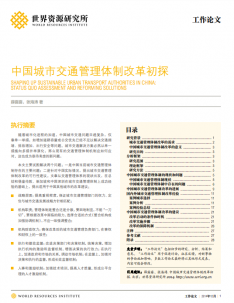Shaping up Sustainable Transport Governance for Chinese Cities: the Status Quo and Solutions

The craft and implementation of timely, effective sustainable transport solutions in many Chinese cities are often obstructed by government fragmentation. This working paper attempts to comb through the problems with the current municipal transport institutional setup and provide concrete recommendations for institutional reform. The research sets the stage for systematically examining the institutional setup of the urban transport sector along the following dimensions: urban transport development strategies, organizational structures, decision-making processes, incentives, and personnel. The targeted audience includes municipal governments, national policy makers in transport, and like-minded NGOs.
Executive Summary
The rapid urbanization that Chinese cities are undergoing has posed mounting challenges for municipal transport authorities to manage the transport sector, deliver necessary services, and device sustainable transport countermeasures. As urban transport responsibilities are commonly scattered among a handful of municipal institutions, the government fragmentation has produced misaligned goals, conflicting policies, and unwise resource allocation (funding and professional skills). In parallel, cities are also deprived of a right mindset on the roles respectively played by government and market. This has led to the monopoly control of urban transport industries, poor transit service quality, inefficient usage of public funding, and the overall lack of private sector’s involvement in delivering public goods and services.
In view of the above institutional barriers, the purposes of the working paper are twofold:
- Provide a deepened understanding of how the existing urban transport institutions fail to facilitate the development and implementation of sustainable transport policies.
- Generate a set of practical recommendations on institutional reform of municipal transport authorities to address the above inadequacies.
Building on international experiences and the specific context of Chinese cities, the paper provides the following recommendations for Chinese cities to streamline the urban transport institutional setup:
- Strategic goals: the responsibilities of new urban transport institutions need to align with the strategic goal of cities’ urban transport development.
- Organizational structure: although institutional reform does not necessarily lead to a single unified institution incorporating the management of multiple modes and functions, inter-departmental coordination or cross-departmental integration is necessary to seek comprehensive measures in addressing urban transport challenges.
- Financial empowerment: the reformed urban transport institution should have financial muscles to carry out new responsibilities.
- Accountability: accountability mechanisms or procedures should be in place to hold both the decision-making and implementation branches accountable.
- Staffing: capacity building and performance incentives are necessary to attract and retain talents.